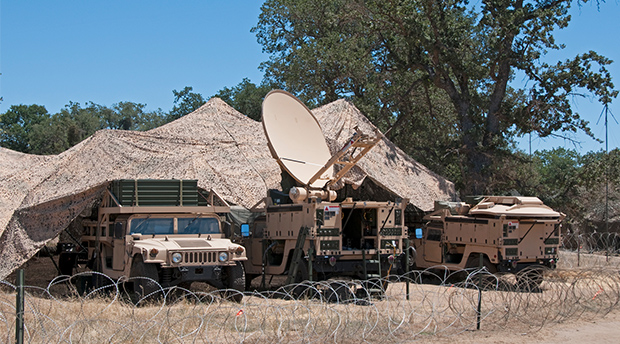By THERESA HITCHENS
SATELLITE 2020: Instead of buying more satellites and bandwidth access, DoD should better manage the satellite communications networks it already uses so troops on the battlefield can stay connected even when those networks are under attack, say top executives at Hughes.
Gen. Jay Raymond’s new Enterprise SATCOM Vision is a step in that direction, according to Rick Lober, vice president of the Defense and Intelligence Systems Division (DISD) at Hughes Network Systems.
“We’re tracking very, very closely General Raymond’s white paper. That talked about more emphasis on network management, which is something I feel Hughes does very well,” he said. Hughes, a subsidiary of SATCOM giant Echostar, provides terminals that link with a number of different satellite networks.
“I think they need to move away from the stovepipe systems to an overarching network management system,” he added. “They need to use network management techniques that give them a lot more efficiency in the use of bandwidth. They waste a lot of bandwidth right now.”
The bottom line is that DoD has yet to shift its mindset away from acquisition and toward putting into place better management structures, said Jeffrey Lessner, Hughes senior director for national programs. “There’s way too much emphasis on either buying more satellites or buying more bandwidth and not enough emphasis on managing what they have,” he said.
As Breaking D readers know, satellite communications are central to the Pentagon’s vision for Joint All Domain Command and Control (JADC2), which is central to enabling the evolving All-Domain Operations strategy to integrate all sensors with all shooters across all five domains of warfare (air, land, sea, space and cyber, and maybe spectrum too.)
Raymond’s concept, as I reported back in October, is called ‘Fighting SATCOM,’ and aims to reduce an adversary’s ability to shut down a mission by attacking a single satellite system. Now that Raymond has signed off on the new vision, industry is hopeful that funding will follow.
“I believe we will see currently funded programs in this area continue with new programs and funding added in the next budget cycle,” Lober said.
Lessner explained that battlefield resiliency for SATCOM will require commanders to quickly assess which networks are operational and which might be under attack.
“They need the tools and the ability to have views into the network to see what is going on,” he said. “They need to have visibility into what is not being jammed and what is being jammed, and how to maneuver around them.”
This is what the new SATCOM Integrated Operations Division being stood up by Space Command in Colorado Springs is supposed to do to cope with the increasing threat of jamming from peer competitors,, he noted.
As Breaking D readers may remember, Army Brig. Gen. Tom James, now the head of Space Command’s Joint Task Force-Space Defense (JTF-SD), announced the plan this past August for the new division during the annual Space and Missile Defense Symposium in Huntsville.
The new division also will figure out how to “allocate the bandwidth across wideband and narrowband satellite systems in conjunction with geographical combatant J-6s (responsible for Command, Control, Communication, and Computers, C4),” he added.
One key to accomplishing Raymond’s goal of a seamless SATCOM network will be applying machine learning and artificial intelligence (AI) techniques to network management. This includes, but is not limited to, development of new types of modems that can hop between commercial and military SATCOM networks — something that Raymond’s new vision specifically calls for.
Lober explained that the idea is to create what is known as a “flexible modem interface — which is kind of flexible networking, if you will — being able to jump on multiple networks, multiple proprietary networks.”
Currently, most SATCOM firms sell access to their networks via company-proprietary modems and terminals that can receive signals from their own satellites, with sometimes only one frequency band. To enable users to ‘roam’ among available SATCOM networks to find the best connection, terminals and antennas have to be capable of catching signals from multiple orbits and be able to function across the spectrum bands used by satellite systems — L-band, Ka-band, Ku-band, etc.
Hughes and Kratos were awarded demo contracts in 2018 by the Space and Missile Systems Center (SMC) for FMI prototypes. In September 2019, Hughes was awarded a follow-on contract, worth $2.2 million, through the Space Enterprise Consortium (SpEC), to produce and demonstrate an “Enterprise Management and Control (EM&C)” prototype based on that FMI design.
Lessner explained that the Hughes FMI will autonomously shift networks in case one connection isn’t working, “so that you’re not left with nothing.”

Hughes is providing upgraded modems for the Army’s MQ-1C Gray Eagle as well as prototyping SATCOM ‘roaming’ capability for SMC.
Under the EM&C contract, Hughes is demonstrating ‘roaming’ terminals for unmanned aerial vehicles. It also intends to show off the “Hughes HM System,” designed to enable UAVs, helicopters and other aircraft to transmit real-time feeds of high-definition video and other intelligence, surveillance and reconnaissance data over satellites.
“We have run phased demos with increasing capabilities, and will continue to do so over the next few months,” Lober said.
Also, on March 11, Hughes was awarded a Data Link Modernization contract by General Atomics Aeronautical Systems to provide air and ground modems for the Army’s Gray Eagle Extended Range Unmanned Aircraft System with software upgrades. According to a Hughes press release, the company will “provide advanced, ruggedized HM400 modems that integrate with the DoD’s waveform technology to support the wide range of unique mission requirements of the U.S. Army – including operations in contested environments.” Hughes will work with Comtech Telecommunications Corp. on the production of ground equipment and waveform technology.

No comments:
Post a Comment